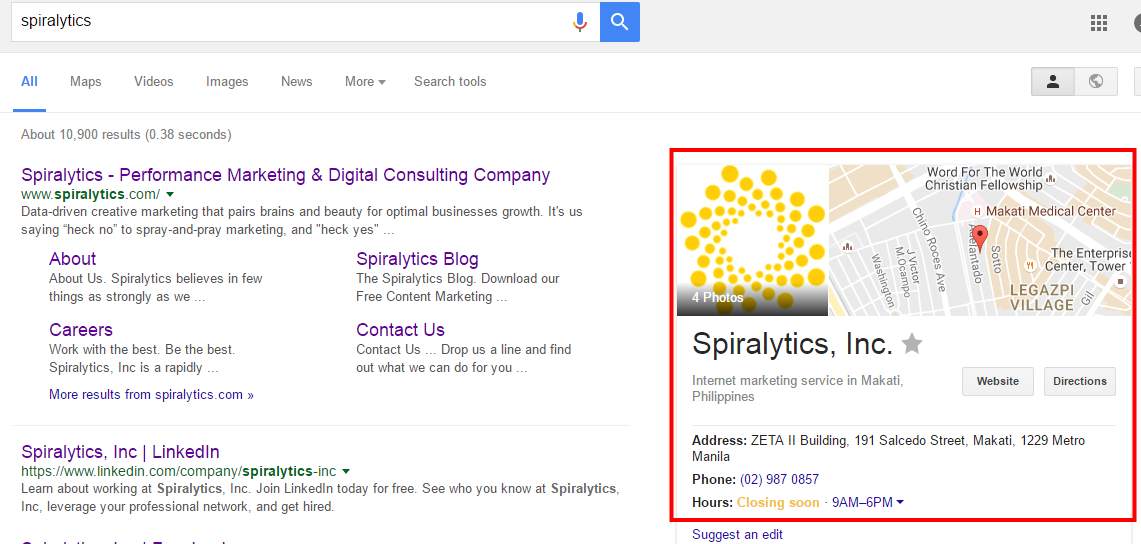Can you believe we’re half-way through 2017? Which means, it’s time to reassess your SEO strategy and see if you’re making progress.
In recent years, many businesses have focused more effort (and budget) on Content Marketing, with little effort on the technical aspects of SEO. But smart digital marketers know that one can’t just set aside technical SEO, focus on Content Marketing, and immediately assume better rankings. SEO is foundational, especially as Google algorithm continues to evolve to meet constantly changing technological trends and user behaviors.
While content will play a massive role in search rankings, SEO trends in 2017 is a lot more technical than most would expect. Get ready to do some serious technical SEO moves, here’s how to rank better in search this 2017.
Part 1: Creating valuable, topical and persona-centric content
Since we already discussed Content Marketing in the intro, let’s start off the list with this one.
In the most recent B2B Marketing survey by Content Marketing Institute, 90% of the top B2B marketers are even more commited to content marketing in 2017, which shows just how effective content is in implementing an effective marketing campaign to grow businesses.
But this also means that the competition is tougher than ever, and content influx is even greater. Hence the need to be more strategic and intentional in using content to make your website visible in Google. Here are key trends in content creation.
1. Create topical content, consider semantic keywords
Gone are the days when we heavily optimize a page using a single all-important keyword. In fact, these days, overoptimizing a page with a single keyword can potentially cause your website more harm than good. Old school keyword density and keyword stuffing are kaput. The key is to make content topical using a collection of semantic keywords, instead of focusing on a single keyword.
Michael Cottam explained this pretty well:
Google has become proficient at understanding the topic represented by the collection of words on a page. They no longer have to rely entirely on things like the page title, H1 heading, anchor text in links to the page, or repetitions of keywords.
As an example, this page ranks #4 for “tahiti weather”…yet not only is the phrase “tahiti weather” not in the page title, or on the page anywhere, but the word “weather” is not present anywhere in the page – not even in ALT text or image filenames.
Google is seeing that much of the page consists of words like “temperature”, “precipitation”, “cyclone”, “season”, etc. and understanding that collectively those terms make up a discussion of the weather.
2. Do keyword research like it’s 2017
Search marketing is still all about keywords, but the way to do Keyword Research has evolved a lot over the years. This means, the way we do it in 2005 or 2010 does not work anymore in 2017.
We like Track Maven’s step-by-step on how to do Keyword Research in this era of semantic, localized and personalized search.
- List down content themes and topics, maybe based it off your products and services, then run your list through a keyword tool. We like using Keyword Planner and Keyword.io.
- Expand your list by thinking of themes based on user-intent, or what keywords your buyer persona might search to find your content. A quick survey among your existing followers, customers or clients is an effective way to do this.
- Combine similar themes together and list down long-tailed / question-based keywords. For example, instead of aiming to rank for “coffee shop”, you should aim for “coffee shops in Salcedo, Makati” or “where to find coffee shops in Makati with wifi”. I mean, who doesn’t ask Google specific and long-tailed questions like that? You know you do. 😉
The result of this process should be a masterlist of topical keywords based on industry data and your understanding of your target market. Then you can build your SEO and Content Marketing strategy based on this masterlist.
3. Don’t ignore the Meta Data
“Meta data does not affect rankings anymore,” is what some of us think. Couldn’t be more wrong.
Admittedly, the Meta Data is the most abused on-page SEO estate, and if you’ve been around the SEO industry this past decade, I’m willing to bet you’ve keyword-stuffed your meta data at some point and considered what you did as “SEO”.
Professionals that provide SEO services have tested and disproved and proved and tested again, over and over, the importance of meta data as a ranking factor. But whether or not meta data is a ranking factor, it still is the snippet of content that shows up on the SERPs. It’s also the description that shows up when your page is shared on social media.

Meta Title and Meta Description when shared on Facebook.
Which means this snippet of content influences Click Through Rate, which makes it quite important don’t you think?
Don’t neglect your Meta Data. Take the time to craft your meta titles and descriptions, position your semantic keywords in your metas, make it descriptive. Apply your copywriting/advertising skills and make it look enticing to click.
4. Optimize your content for users, not bots
SEO is not anymore about making your website search-friendly; these days it’s all about making it user-friendly. The ironic thing about SEO is, the more you make your pages “search-friendly”, the more chances you overoptimize and get penalized. But when you focus on user experience, and creating content that’s easy to read and consume by humans (instead of bots), that’s when your pages start to rank better, get linked to, and shared more.
{{cta(‘0d2f5bc6-6726-4ce9-a419-15277c4a635e’)}}
Part 2: Optimizing for mobile search
In this roundup by Almeda Internet Marketing, the #1 trend as identified by SEO experts is “mobile optimization.” “Voice search” came in 3rd, which as we all know is applicable mostly to mobile phones. Consequently, search inquiries coming from mobile phones have exceeded inquiries that come from desktops, and we can only expect an even greater growth moving forward.

Here are a few quick stats on just how important mobile optimization is:
- 48% of consumers start mobile research with a search engine. (Smart Insights)
- 37% of all website visits come from mobile devices. (Device Atlas)
- 86% of all organic search visits in the US and 90% percent of mobile organic search visits came from Google. (Search Engine Watch)
This tremendous growth in mobile usage is why Google strives to make search more personalized and localized and why marketers now have to optimize websites for things like Knowledge Graph and Hummingbird, and why Schema Markups and AMP are necessary.
To optimize websites for mobile search, it’s necessary to do the following:
5. Set up Accelerated Mobile Pages
Accelerated Mobile Pages or AMP is another one of Google’s initiatives to make web pages optimized for mobile. The AMP format is stripped off anything that slows the website down, like lead capture forms or comments section, causing the pages to load faster by 15 t0 85%.
Search Engine Watch had an in-dept explanation of AMP here, if you want to see.
Incidentally, AMP was originally built for content-heavy sites and publishers (think Facebook Instant Articles), but this year we’ve seen e-commerce sites and other industries “AMP” their websites too.
When the AMP project was initially rolled out in February 2016, SEO experts were a bit skeptical about its long-term SEO value. But Google, through representative Adam Green, has confirmed during the recent SMX East that Google now links to AMP pages in search results, claiming that the AMP project is quite “central to the company’s plans.” I think it couldn’t get any more confirmed than that.
Plus, it does make a web page load faster on mobile, and we all know that mobile-friendly and fast loading sites earn extra points on Google, as well as human approval.
Which brings us to the next point.
6. Acknowledge the need for speed
Mobile search is bigger than ever, and mobile searchers are more impatient and impulsive than ever too. Understandably, when someone’s browsing websites on a small screen, or doing a voice search while driving around the neighborhood looking for a place to hang out, speed is quite important.
Fast loading sites are a mobile searcher’s best friend, in fact, in 2015 Google rolled out a huge algorithm change that favored mobile-friendly websites. Remember the mobilegeddon? Did you panic too when that happened?
Optimizing pages to load faster both for mobile and desktop is important, and here are just some practical ways to do it:
- Optimize images for web (resize, if possible save as .jpg instead of .png)
- Lessen the use of flash
- Minify HTML, CSS and javascript codes
- Hide pop-ups on mobile browsers
- Upgrade your plugins and delete inactive plugins (for WordPress users)
- Periodically re-assess your hosting plan
Obsessively make your website pages load fast. And of course, definitely consider #5.
7. Optimize for the “Micro Moments”
We’re going beyond SEO at this point, as we begin to think more about how to address behaviorial shifts in mobile search and customer journeys.

As mentioned above, searches done on mobile devices have exceeded searches done on desktops over the past year. But this growth in mobile search does not exactly take away from the aggregate time spent on bigger screens. Instead, mobile search has opened up an entirely different world of impulsive search activities, which Google aptly calls “micro moments”.
Search Engine Land explained it best:
“Consumers aren’t using their mobile devices as a replacement for their desktop computers — they are using these devices in whole new ways that weren’t previously possible. The proliferation of mobile devices means that consumers can now take action to address their needs immediately and on the fly.”
In short, users turn to mobile search specifically to fulfill an immediate need, or to find an immediate answer, hence micro-moments:
- I-want-to-know moments
- I-want-to-go moments
- I-want-to-do moments
- I-want-to-buy moments
It’s easy to think of these “micro moments” as something that’s more applicable to e-commerce or brick-and-mortar businesses, but truth is, this is as relevant to B2B as it is to any other business models.
We like B2Bento’s take on micro moments for B2B:
“In the B2B space, a need to buy a product triggered solely by emotion cannot culminate in a purchase. But, a prolonged engagement, especially at the right moments, through thoughtful and sensitive content, can make a lot of difference.”
Seeing that “micro moments” is all about user behavior and customer journey, this plays into the SEO ball game in a huge way, starting from building up your keyword masterlist, to optimizing your pages, to creating and distributing content that appeals to those impulsive, zero-moment-of-truth decisions.
Part 3: Optimizing for Local Search
Closely tied to mobile optimization is getting your website optimized for local search. And again, this is not just applicable to brick and mortar businesses, this applies to pretty much all business models and industries.
The essence of Local Search is really about making it easy for people to find and navigate through your website, and to act on something. This section overlaps with mobile optimization in a huge way. Aside from AMP, speed, and mobile-friendly pages, here are other important steps to optimize your website for local search.
8. Claim your listing on Google Business
Chances are, you ignored this part because you didn’t think it was important. And chances are, your competition took this seriously so now your target market can contact your competition faster than they can even locate you.

Being in Google Business is even more important when people search your very own brand keywords.
When people search the name of your company, the intention is quite clear—they already know who you are, and they might want to reach out to you, get to know you more, or inquire about your products and services. Take note, this is most likely captive audience—precisely why you need to make it easier for them to find and reach you.
Here’s how to do it: Fill up the Google My Business form with all the necessary information. Contact details, address, business category, business hours, photographs of your building, etc. Add photographs of your employees even, if you feel like associating real people to your brand. Verify.
Then get your address and contact details up on your website and make this information visible in your footer (or any section that shows up site-wide). Should you have offices in various locations, make sure you have landing pages for each location as well, like how we created a page for our UK office since we offer Digital Marketing in Nottingham, too.
Search Engine Journal discussed Local Search Optimization in detail here.
9. Implement Schema Markup
You know those Quick Answers and Featured Snippets that have been showing a lot more frequently on Google search results pages lately? These are based on the Knowledge Graph, a massive database of information built by Google since the beginning of 2012.
Certain search queries trigger these “boxed” information to show up in prominent areas of the search results. With the appearance of these rich content snippets, users don’t even have to click through a website anymore to find the answer that they’re looking for.
 We see this quite a lot when we’re searching for currency conversions, locations, definition of terms, recipes, videos, autobiographies and profiles, among others. By implementing schema markup, search engines find it easier to understand websites, and display relevant information correctly on the SERPs.
We see this quite a lot when we’re searching for currency conversions, locations, definition of terms, recipes, videos, autobiographies and profiles, among others. By implementing schema markup, search engines find it easier to understand websites, and display relevant information correctly on the SERPs.
To get your Schema set up, use Google’s Structured Data Markup Helper.
10. Give special attention to user experience
All of the above, really, is about user experience. SEO has always been about attracting humans and not just gaming search engine algorithms.
When you design your website, when you create content, when you optimize your pages, think about User Experience. What are the pages that they likely want to see if they’re viewing the page on desktop? How about on mobile? Is your website compatible with desktop browsers as well as mobile devices? Does it load fast? Are you using the right words that appeal to their type of people? Is the site easy to navigate?
You already won half the battle when you get user experience right.
Interestingly, in this survey among SEO gurus, only 5 (out of 39) mentioned “link building,” “outreach” and “influencer marketing” as SEO trends to focus on. While there’s a whole lot of stuff to do on-page, these off-page strategies are equally important.
11. Get social and build relationships with peers and influencers
Reaching out to influencers is a good way to get your brand in front of bigger audiences, but building relationship with industry peers is also beneficial. There are many ways to do this, as such, “Tribe Building” (peers) and “Influencer Marketing” (influencers) have become buzzwords in the digital marketing industry.
When you reach out to peers and influencers, you want to build a relationship more than just “get links”. Which means, you have to prepare something of value to share to them, whether it’s a guest post opportunity, or a blog review, or a testimonial. Be generous in linking to them or sharing their content, such that, when it’s time for you to pitch your own article, they already know who you are.
We talked about 3 of our favorite outreach strategies here.
12. Make content distribution a habit
This is where we go full circle. The truth is, when you have an abundance of good and valuable content (as discusssed above), content distribution naturally becomes a habit.
The whole point of this, of course, is to earn links and social signals and to build up your website’s authority, therefore making your pages rank better in search. Now, most link building strategies are not new. Marketers just have to think of more creative and genuine ways to do them. Content creation and outreach is what’s going to build you those much needed links.
How’s your website ranking lately? If you want to learn more about our SEO services, visit our website today!
{{cta(‘600a041e-e2d7-4435-8dde-b499b8c98dd9’)}}



